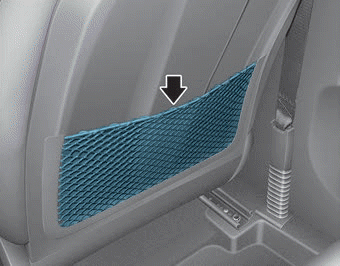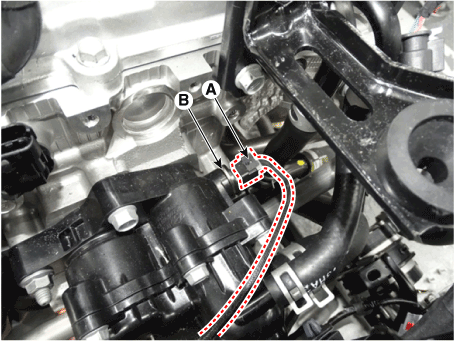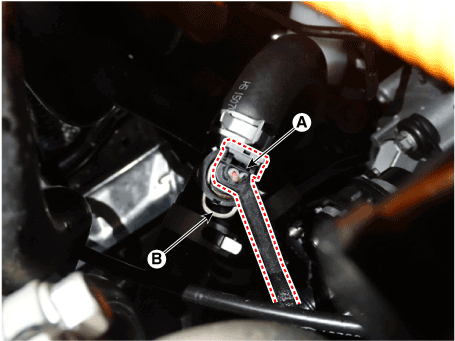Hyundai Ioniq: Engine Control System / Engine Coolant Temperature Sensor (ECTS). Repair procedures
Hyundai Ioniq (AE) 2017-2025 Service Manual / Engine Control/Fuel System / Engine Control System / Engine Coolant Temperature Sensor (ECTS). Repair procedures
| Inspection |
| 1. | Turn the ignition switch OFF. |
| 2. | Remove the ECTS. (Refer to "Removal") |
| 3. | After immersing the thermistor of the sensor into engine coolant, measure resistance between the ECTS terminals 1 and 3. |
| 4. | Check that the resistance is within the specification.
|
| Removal |
Engine Coolant Temperature Sensor (ECTS) [Water Temperature Control Assembly]
| 1. | Turn ignition switch OFF and disconnect the negative (-) battery cable. |
| 2. | Remove the air cleaner assembly (Refer to Engine Mechanical System - "Air Cleaner") |
| 3. | Remove the purge control solenoid valve. (Refer to Engine Control System - "Purge Control Solenoid Valve (PCSV)") |
| 4. | Disconnect the engine coolant temperature sensor connector (A). |
| 5. | Remove the engine coolant temperature sensor after removing the fixing pin (B).
|
| 6. | Fill with engine coolant. (Refer to Engine Mechanical System - "Coolant") |
Engine Coolant Temperature Sensor (ECTS) [EGR Cooler Tube]
| 1. | Turn ignition switch OFF and disconnect the negative (-) battery cable. |
| 2. | Remove the air cleaner assembly (Refer to Engine Mechanical System - "Air Cleaner") |
| 3. | Disconnect the engine coolant temperature sensor connector (A). |
| 4. | Remove the engine coolant temperature sensor after removing the fixing pin (B).
|
| 5. | Fill with engine coolant. (Refer to Engine Mechanical System - "Coolant") |
| Installation |
|
|
|
| 1. | Install in the reverse order of removal.
|
Other information:
Hyundai Ioniq (AE) 2017-2025 Service Manual: General safety information and caution
Safety PrecautionPrecautions To Take Before Servicing High Voltage System • Since hybrid vehicles contain a high voltage battery, if the high voltage system or vehicles are handled incorrectly, this might lead to a serious accidents like electric shock and electric leakage...
Hyundai Ioniq (AE) 2017-2025 Service Manual: Door Step Trim. Components and components location
C..
Categories
- Manuals Home
- 1st Generation Ioniq Owners Manual
- 1st Generation Ioniq Service Manual
- Towing
- Child-Protector Rear Door Locks
- Checking the Coolant Level
- New on site
- Most important about car
Seatback pocket

The seatback pocket is provided on the back of the front passenger's seatback.
WARNING
To prevent the Occupant Classification System from malfunctioning:
Copyright © 2025 www.hioniqae.com






